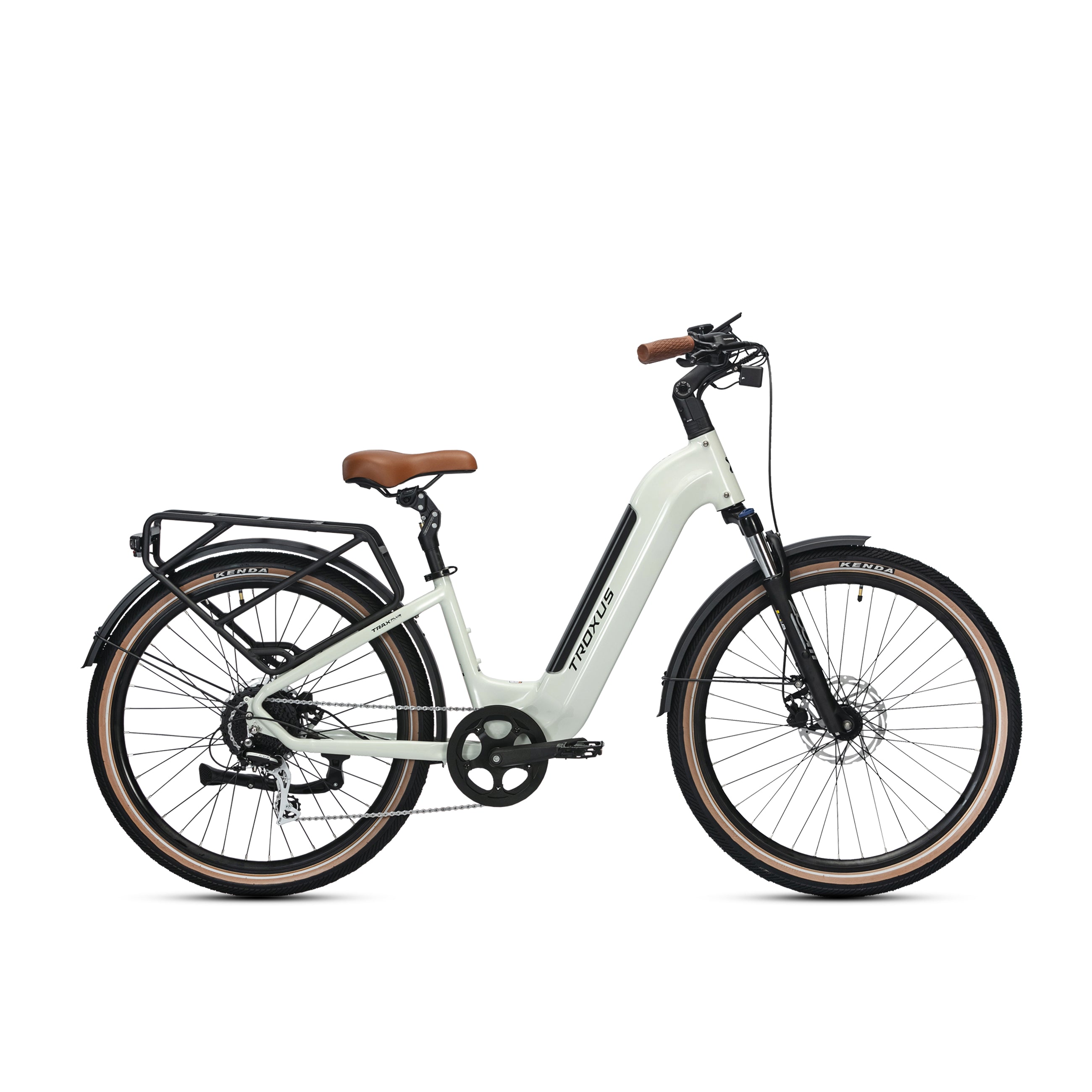Saddle up and prepare to power through a fascinating exploration of the bicycle world's cutting-edge: electric bikes. These innovative rides aren’t just reshaping our idea of personal mobility; they’re rewriting the economics of daily travel for millions worldwide. If you think these sleek silent machines are just a contemporary fad, think again. Electric bikes are becoming the vehicle-of-choice for a generation unafraid of pedaling into the future.
In this extensive guide, we’ll pedal right into the core of electric bike ownership, uncovering how they not only pave the way to personal financial health but contribute to our planet's well-being. From initial investments to the many nuanced savings electric bikes offer, we'll analyze every spoke of the wheel to show how these eco-friendly "e-bikes" deliver long-term benefits that are more than just a passing fad.
Content
Initial Investment vs. Long-Term Savings
Health Benefits and Healthcare Savings
Government Incentives and Supporting Policies
Quality of Life and The Electric Edge
Initial Investment vs. Long-Term Savings
Don't let the upfront price of an electric bike fool you; these fancy machines might cost more than regular bikes, but they bring lots of benefits that make them a smart buy. Electric bikes can help you save cash on gas and parking if you usually drive to work or school. And that's not all. With an electric bike, you can ditch expensive gym memberships or personal trainers because your daily ride can also be your workout. Plus, electric bikes are way cheaper to maintain than cars, so they're a wise money choice in the long haul.
The Initial Investment
Just like any vehicle, the buying process of an electric bike is an exercise in decision-making. Understanding the initial cost and its relation to the subsequent savings will set the wheels in motion for an economically sound investment.
How Much Does an Electric Bike Cost?
The sticker price of an electric bike can be a touch higher than its non-electric counterparts, but this initial outlay is the first step towards a robust financial plan. We'll break down the average cost and guide you through what to look for to ensure a bike that’s both a sound financial investment and tailored for your lifestyle.
Beyond the Bike: Assessing the Essential Accessories
The electric biking experience doesn’t end with the bike itself; it requires a suite of accessories for performance, safety, and maintenance. Evaluate essential equipment like helmets, specialized locks, and deterrent systems to safeguard your investment from the elements and unwanted attention.
Sizing Up the Exercise in Maintenance
Compared to traditional bicycles, electric bikes do have additional components that require care. Knowing how to maintain these elements – such as the battery and motor – can affect the bike's longevity and is crucial in maximizing cost reduction.
Long-Term Payoffs
The road to financial wellness with electric bikes is a paved one, and the savings can accumulate faster than you can say "Vélo électrique."
The Deflation of Fuel Costs
For every mile an electric bike travels on battery power, another expense falls away. These expenses include reduced fuel costs, maintenance savings, and a lower environmental impact. We'll detail how these nominal everyday costs add up cumulatively over time to result in significant and robust long-term savings for electric bike owners.
Diminishing Depreciation
In contrast to the swift depreciation witnessed in many new technological innovations, electric bikes exhibit a noteworthy trend of sustaining a comparatively high resale value over time. The subsequent section will intricately explore the factors contributing to this advantageous trend, including ongoing technological advancements in electric bike design, the growing consumer demand for sustainable transportation alternatives, and the overall positive environmental impact attributed to electric bikes.
The Subtle Investment in Health and Well-being
An electric bike is not just a means of transportation; it's a valuable investment in both your physical well-being and financial future. By embracing the regular exercise facilitated by an e-bike, you can potentially reduce the number of visits to the doctor and pave the way for a healthier and more secure financial outlook in the long run.
Reduced Commuting Costs
Fuel Savings
Transitioning to an electric bike for your commute not only catapults you into a greener lifestyle but also sends your fuel expenses plummeting. The cost of charging an electric bike is mere pennies compared to fueling a car or even hopping on public transit. We’re talking about going the distance for less than a cup of coffee! This isn't pocket change over time; it's a significant pool of savings. By choosing electric, you’re not just navigating the urban jungle with ease and style; you're also paving a path to financial freedom.
Maintenance Cost Comparison
When it comes to the savings that an electric bike can offer, the maintenance costs are where you truly see the difference sparkle. Unlike their fuel-guzzling counterparts, electric bikes whisper a promise of lower upkeep costs, and they deliver with gusto! Sure, both electric and conventional bikes have their share of maintenance needs—think tire replacements and brake pads—but e-bikes play an ace with their electric components. The electric drive system is surprisingly low-maintenance compared to the complex engines and transmission systems in cars. There’s no oil to change, no spark plugs to replace, and certainly no exhaust system repairs to worry about. This not only saves you a hefty amount in potential repair costs but also spares you from the time-consuming visits to the mechanic.
Additionally, when we bench-press the numbers, conventional bikes, while cheaper upfront, can have similar maintenance costs to electric bikes without offering the same commute-shrinking superpowers. This is especially true when considering higher-end models designed for performance; they need just as much care, if not more, due to their intricate mechanical parts. And cars? The comparison almost seems unfair. The average cost of car maintenance, including oil changes, brake repairs, and tire rotations, can spiral to hundreds, if not thousands of dollars a year. Pair this with the fact that electric bikes help dodge parking fees and congestion charges, and you realize—electric bikes aren’t just saving the planet one pedal at a time, they’re guarding your wallet too.
With an electric bike, you’re not just investing in an efficient way to zoom past morning traffic; you’re securing a future of savings. The road ahead looks smooth, with more money in your pocket and less spent on keeping your ride in tip-top shape. Buckle up, because the electric bike revolution is not just about moving forward, it’s about moving forward smarter and with more jingle in your pockets!
Health Benefits and Healthcare Savings
By incorporating electric biking into your daily routine, you're paving the way for a healthier financial future. Consider the savings from fewer medical bills and health insurance premiums; it's like putting money back into your pocket. Plus, with the added zeal for life that comes from being physically active, you're setting up a positive feedback loop that fuels itself—more energy for biking leads to better health, which in turn saves money, giving you even more reason to keep pedaling.
Physical Health
Imagine this: Instead of spending hours cramped in a gym, your daily commute doubles as your workout, with the fresh air as your companion. That's the delightful reality with electric bikes! Regular use of an e-bike isn’t just a breeze on your commute; it’s a full-blown gust of wind propelling you towards outstanding physical health. You might wonder, “How does something that feels so effortless contribute to my fitness?” Well, electric bikes come with a magical blend of pedal power and electric assist, allowing you to tailor your workout intensity. This means you can burn calories and build muscle at your own pace, without the daunting prospect of overexertion.
What’s truly exciting is the domino effect this has on your long-term health. Engaging in low-impact, moderate exercise like e-biking can vastly improve cardiovascular health, decrease blood pressure, and reduce the risk of Type 2 diabetes. Each pedal push sends a wave of good vibes to your heart, your muscles, and even your brain, proving that good things come to those who bike.
The financial cherry on top? The healthier you are, the less you're likely to spend on healthcare down the line. Fewer doctor visits, less need for medication, and a lesser chance of chronic disease—all of which can significantly reduce your medical expenses. In a world where healthcare costs are only rising, who would’ve thought the path to saving could be paved with two wheels and a battery?
In essence, the electric bike revolution is not just about cutting down carbon emissions or easing traffic congestion; it's also about boosting your physical health in an incredibly fun and efficient way. With every mile, you're not just moving towards your destination; you’re pedaling towards a healthier, wealthier you.
Environmental Impact
Embracing the seat of an electric bike signifies more than a personal commitment to health and financial stability; it's a significant stride for our environment. Electric bikes stand as a beacon of eco-friendly technology, mitigating carbon footprints with each ride. Envision a world where streets echo not with car engines but the gentle hum of electric bikes—a vision extending beyond a cyclist's ideal to a cleaner, healthier planet. The allure of e-bikes lies in their efficiency and simplicity. Fueled by rechargeable batteries, these vehicles emit zero pollutants, emerging as environmental champions against air pollution. Each mile on an electric bike contributes to curbing greenhouse gases, propelling us toward a future where clean air is the standard. Additionally, the energy used to charge electric bikes can be derived from renewable sources, amplifying their environmental benefits. Beyond emissions, electric bikes address noise pollution, offering a serene alternative to the clamor of gas-powered traffic, paving the way for more tranquil urban environments. The profound ripple effects of this e-bike wave extend beyond personal choices; they represent a global shift toward sustainable living. This narrative of innovation intertwines technology and eco-consciousness, guiding us towards a cleaner, greener future. The revolution is underway, and it radiates a vibrant shade of green!
Government Incentives and Supporting Policies
The enthusiasm for electric bikes isn't unilateral; governments worldwide are pedaling policy to match consumer demand. From tax incentives to rebates, this section lays down the official financial support available for those who ride the electric wave.
Which Electric Bikes are Eligible for the Tax Credit?
To be eligible for the tax credit, an electric bike must meet the following criteria:
- The bike must feature a robust motor with a capacity of under 750 watts.
- It should fall under class 1, class 2, or class 3 categories, and must be equipped with pedals for propulsion.
- Additionally, the bike should have the capability to transport a single individual.
Tax Credits and Rebates
Just as electric bikes charge up with electricity, the government charges up e-bike adoption with financial incentives. In Europe, the support for e-bikes is even more widespread, with countries like France and Portugal offering financial incentives for electric bike purchases. Schemes such as the French "Bicycle Bonus" provide a rebate of up to €200 for buying an e-bike, while in Portugal, residents may receive aid up to 50% of the purchase price of the vehicle, including VAT, to a maximum of €500. In the United States alone, there are currently over 20 states and cities that offer tax credits or rebates for purchasing an electric bike. These can range from a few hundred dollars to even thousands of dollars, depending on where you live and your specific circumstances. For example,
- Federal Tax Credit: The U.S. federal government offers a tax credit of up to $7,500 under Internal Revenue Code Section 30D for electric bike purchases.
- California Rebate: The California Air Resources Board (CARB) is responsible for the statewide e-bike incentive program, it claims California provides a rebate of up to $1,000 for e-bike buyers and up to $1,750 for a cargo or adaptive e-bike.
- Oregon E-Bike Credit: According to Go Electric Oregon, "The Oregon Department of Environmental Quality’s Oregon Clean Vehicle and Charge Ahead Rebate programs can save Oregonians up to $7,500 on the purchase or lease of a qualifying electric vehicle. All Oregonians can receive up to $2,500 for the purchase or lease of a qualifying new EV. Low- and moderate-income Oregonians can save an additional $5,000 on qualifying new or used EVs."
- New York E-Bike Incentive: The Ride Clean electric bike program provides an immediate 50% rebate to anyone buying an electric bike, up to $1,100.

Depreciation and Resale Value
The depreciation of an electric bike (e-bike) refers to the decline in its value over time, influenced by factors such as wear, technological advancements, and market changes. Electric bikes from reputable brands, well-maintained, and equipped with desirable features may experience slower depreciation. Resale value, on the other hand, is the estimated worth of an e-bike when sold or traded. Factors like brand reputation, overall condition, added upgrades, and market demand influence resale values. Electric bike owners can maintain higher resale values through regular maintenance, choosing reliable brands, incorporating upgrades, and staying informed about market trends. Understanding these dynamics is essential for electric bike owners, impacting the overall cost of ownership and potential returns during resale or upgrades.
The Market Dynamics of Electric Bike Resale
The secondhand market for electric bikes is experiencing a surge in activity, fueled by various factors that infuse it with energy and liveliness. Within this dynamic landscape, we aim to thoroughly investigate the distinct preferences of buyers, delving into the specific features and attributes they value most in their quest for the perfect electric bike. Additionally, our exploration will extend to the innovative strategies that sellers can implement to effectively cater to these preferences, ultimately boosting the chances of securing a successful and mutually beneficial transaction. By understanding and adapting to the evolving needs and desires of both buyers and sellers, we can further enrich the electric bike market and foster a thriving ecosystem for all involved.
Maintaining Resale Value
Just like cars, the maintenance of an electric bike significantly impacts its future resale value. In this comprehensive guide, we delve into the importance of regular maintenance routines, emphasizing the critical aspects such as checking tire pressure to ensure optimal performance, cleaning the drivetrain thoroughly for longevity, and inspecting the battery health to maximize its efficiency over time. These best practices not only guarantee that your e-bike runs smoothly but also contribute to preserving its sleek appearance, enhancing its overall aesthetic appeal. By diligently following these expert tips and incorporating them into your maintenance regimen, you can be confident that your electric bike's second life will be just as rewarding for your wallet as its initial use.
Quality of Life and The Electric Edge
Beyond the finances and environmental scorecards, electric bikes enrich life in tangible ways. In this section, we’ll explore the intangible yet invaluable quality-of-life improvements that come with electric riding.
Time Management
Time is a precious commodity, often described as the currency of life. In this context, we will explore the intricate comparison of commute times across various modes of transportation, ranging from traditional methods to modern innovations. Our primary objective is to vividly showcase how e-bikes, with their eco-friendly and efficient nature, have the inherent capability to reclaim not just minutes but potentially hours from your daily routine. These saved intervals, once underutilized, can be strategically reallocated to enrich your personal experiences, enhance productivity levels, or indulge in fulfilling leisure activities. By embracing e-bikes as a transformative element in daily commuting, individuals can unlock a newfound realm of time management strategies, elevating the overall quality of life to unprecedented heights.
The Joy of Riding Stress-Free
We make it a priority to steer clear of stress throughout our day, understanding stress as a silent adversary with far-reaching impacts on our health and financial security. By delving deeply into the stress levels experienced during commutes that encompass a range of transportation methods, our goal is to showcase the serene and enjoyable riding experience that e-bikes provide. This not only leads to improved well-being but also brings about indirect financial benefits, offering a win-win situation for both our physical and financial health.
Group Riding and The Social Currency of Electric Bikes
Electric bikes offer not just personal benefits but social ones as well. In this part, we’ll explore how group riding can enhance a sense of community, expand social networks, and potentially lead to shared resources that can save money all around. When individuals come together for group rides, they not only enjoy the physical and mental health benefits of cycling but also establish lasting connections with like-minded individuals. Moreover, sharing resources such as knowledge about routes, maintenance tips, and even equipment can foster a supportive and collaborative environment within the cycling community. This sense of camaraderie and shared experiences further strengthen the bonds among riders, creating a network that extends beyond the saddle.
Conclusion
The deep exploration of the economic landscape of electric bikes uncovers layers of savings that even the most enthusiastic riders might not fully appreciate. The upfront investment in an electric bike is a stepping stone to a future filled with financial benefits, environmental stewardship, improved health, and an enhanced standard of living. With the statistics and savings tallied and the benefits outlined in glowing electric bike green, it's clear that the electric bike isn't just another consumer good; it's a smart, sustainable investment in your personal economics. With each pedal push on an electric bike, you’re not just moving forward in the present; you’re steering towards a future where fiscal responsibility and personal health move in harmony with the Earth’s ecological needs.
In the end, the economics of electric bikes aren’t just about how much you spend; it's about the powerful ways you can save – your health, your time, and your planet. Make the investment in an electric bike today, and start reaping the dividends of a greener, wealthier future tomorrow.








